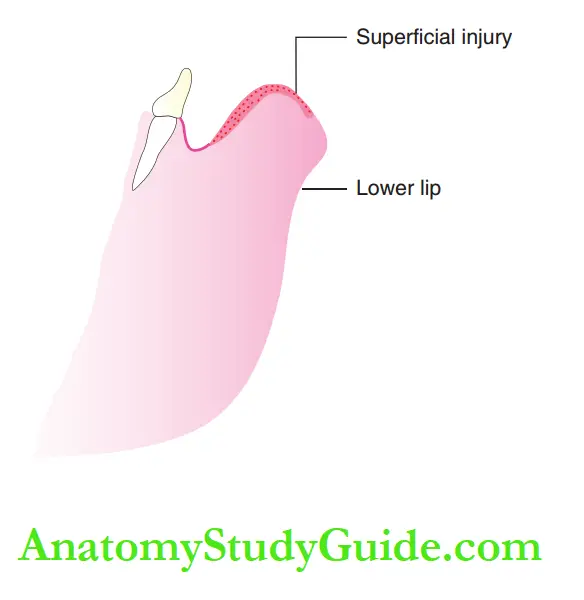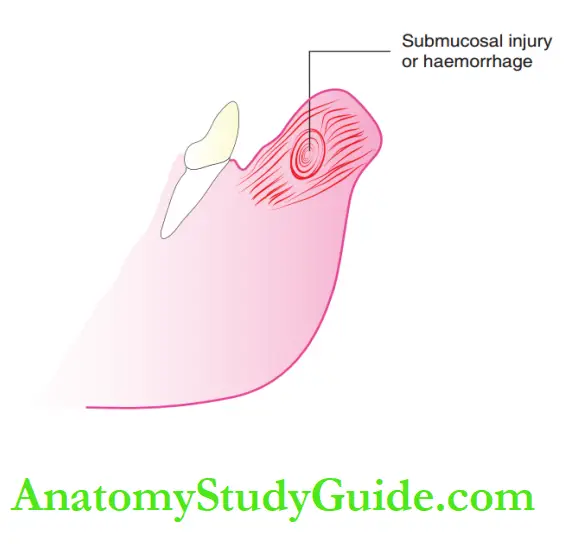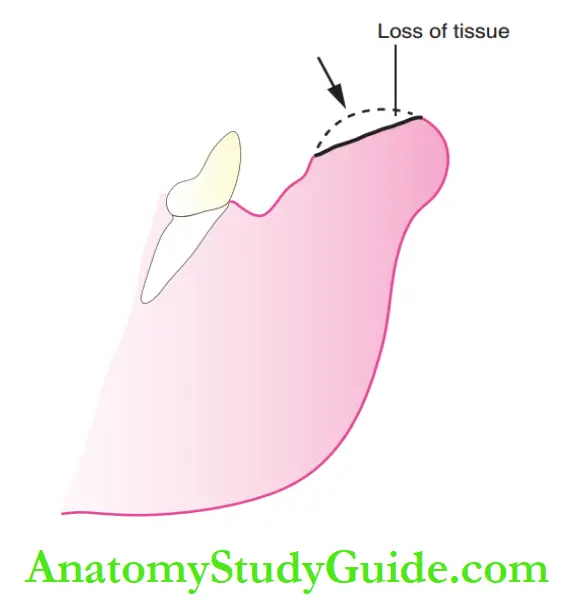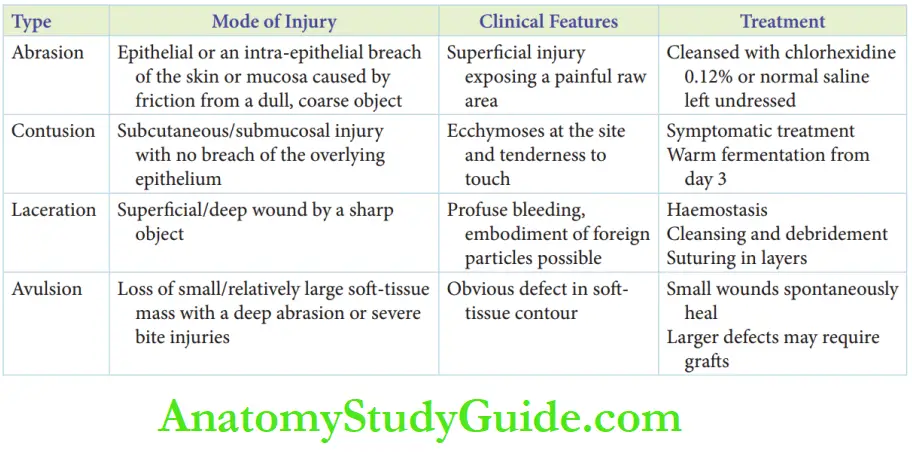Oral Soft Tissue Injuries Introduction
Oral soft tissues that are commonly inflicted during orofacial trauma are lips, gingiva and oral mucosa.
Table of Contents
Soft tissues encounter trauma during a direct sharp injury or while dissipation of dull trauma owing to relatively higher resiliency compared to hard tissues.
The cushioning effect of the lips absorbs/dissipates the impact on teeth in some traumas.
| Body Fluids | Muscle Physiology | Digestive System |
| Endocrinology | Face Anatomy | Neck Anatomy |
| Lower Limb | Upper Limb | Nervous System |
Cheeks and tongue are less commonly involved. The gingival tear is common in case of displacement of teeth.
Penetrating injuries of the lip are the commonest traumas of the soft tissues.
The extent/severity of trauma depends on the size, shape, resiliency and velocity of the object.
Th four types oforal softtissue trauma are abrasion, contusion, laceration and avulsion.
Abrasion and contusion are common in dull injuries and laceration and avulsion are common in sharp injuries.

Abrasion
An epithelial or intra-epithelial breach of the skin or mucosa is an abrasion injury.
Abrasion is caused by a dull, coarse object in lieu of the friction that it creates on the soft tissue during impact.
Clinically, an abrasion injury is a superficial injury exposing a raw area.
Abrasion can be quite painful owing to the exposure of terminal nerve endings.
Abrasion Treatment:
The wound is cleansed with chlorhexidine 0.12% or normal saline to remove foreign particles and decrease microbial contamination.
Abrasion is done after an application of 5% local anaesthetic gel.
Skin abrasions may be left undressed (open) with an application of an emollient cream to prevent dehydration and a sunscreen lotion (sun protective factor) to prevent hyperpigmentation.


Contusion
Contusion injury is a subcutaneous or submucosal injury with no breach or discontinuity of the overlying epithelium.
A contusion injury is caused by a dull object infecting a blunt trauma resulting in a subcutaneous/ submucosal haemorrhage.
However, Contusion runs the risk of being associated with a fracture of the underlying bone.
Clinically, contusion, limited to only soft tissue injury, shows ecchymoses.
The skin becomes tender to the touch. When a bony injury is associated, it presents a step defect during palpation.
Contusion Treatment:
- Contusion injury with no bony involvement needs only symptomatic treatment.
- When the injury involves bone, it has to be treated appropriately.
- Anti-inflammatory medication is advised. Warm water fermentation is recommended from the third day.
- As ecchymoses involve a haemorrhage of blood vessels, warm water fermentation may accentuate the bleeding within the tissues (interstitial haemorrhage).
- From the third day, it enhances blood supply to the contused area, promoting clearance of the blood clot.

Laceration
- A laceration is a deep or superficial wound arising from a tear. Laceration injury is caused by a sharp object creating a deep/shallow wound.
- Laceration involves the epithelium and dermis and may also involve deeper structures such as nerves, blood vessels, salivary glands and ducts, and muscle fires.
- Clinically, the wound is expected to bleed profusely. Bleeding can be excessive where arterial anastomosis of the lower lips at midline or of the larger vessels is involved.
- Foreign bodies such as teeth fragments can be embedded into soft tissues.
- Loss of bits of tissue or loss of blood supply to the terminal portion at the site of incision can also be expected.
Laceration Treatment:
- Haemostasis is the primary objective, especially when wounds are deep.
- The tissue is then inspected to identify embedded foreign bodies.
- Radiographic investigation can supplement inspection to prevent the embodiment of such fragments.
- The wound is then well-washed with chlorhexidine and saline.
- Devitalised/torn bits of tissue may enhance the spread of infection to deeper tissues.
- These are removed. Debridement and cleaning have to be performed with self-imposed restriction as the head and neck region has a rich blood supply.
- This can derail haemostasis. The wound has to be sutured in layers. Muscle suturing is performed with resorbable sutures.
- Outer cutaneous/mucosal sutures may be resorbable or non-resorbable.
- Post-operative antibiotics and analgesics are recommended.
- The wound is reviewed on day three and the outer sutures are removed on a fit day.
Avulsion
Avulsion implies the loss of small/relatively large soft tissue mass during an injury.
Although rare, an avulsion is possible with a deep abrasion or with severe bite injuries.
Clinically, the wound demonstrates an obscured anatomy but with an obvious defect in the soft-tissue contour.
Avulsion Treatment:
- The defect, if small, is allowed for spontaneous healing under the secondary intention.
- In case of large defects, coverage of the defect with graft/flips
is attempted. - Conclusively, prompt emergency care and appropriate definitive therapy determine the prognosis of a soft tissue injury.
- Healing with an obvious scar and embodiment of foreign particles/teeth fragments are some of the undesired consequences.

Oral Soft Tissue Injuries Summary
1. Oral soft-tissue injuries may be classified as follows:

Leave a Reply